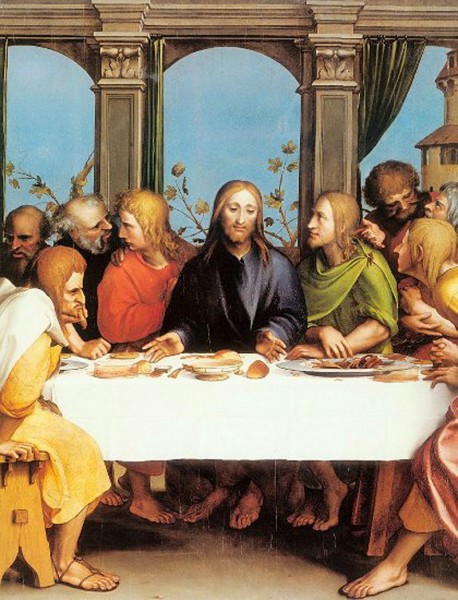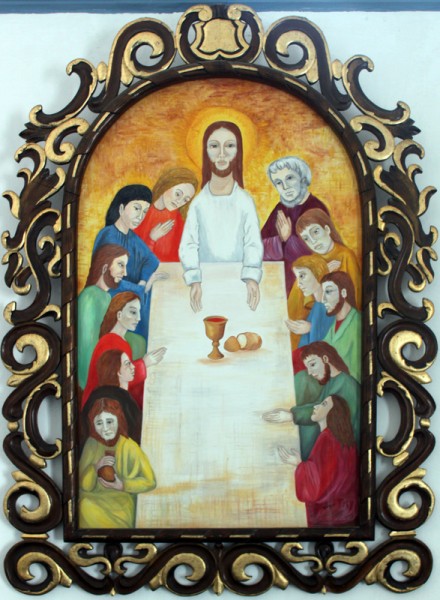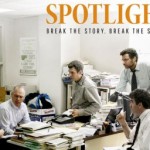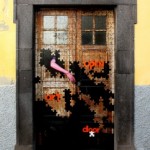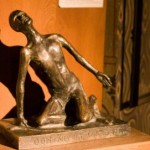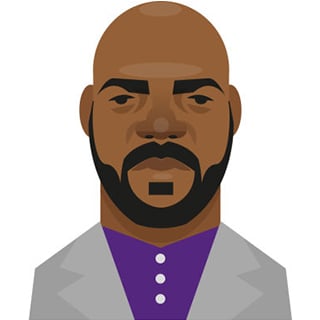Please note: Unless otherwise cited below, this service was written by, or adapted from the Haggadah by, Nancy Rockwell.
The Night of the Beloved Community
(This service is set around tables and includes a simple supper of chicken noodle soup, people signed up to bring a pot for eight, and a veggie soup, and a gluten free soup. We also served bread, cheese, and fruit, and everyone was satisfied. Attendance went way up for this service, compared to the older, more formal liturgy We printed the hymns into a little booklet, so the each seat had a service leaflet and a hymn booklet. The tables also held small bowls of charoset, pieces of boiled egg, matzoh, salt water, and sprigs of parsley, for the Seder rituals. And the room was lovely, with purple table cloths and yellow napkins, purple candles and branches of forsythia in vases on the floor. The tables (for 100) were in a semi-circle around the ritual table, which held a Seder plate, bread and wine and grape juice, and candles for Tenebrae.)
Opening Hymn Day Is Done
Opening Words T.S. Eliot
The lights are extinguished, for the scene to be changed
with a hollow rumble of wings,
with a movement of darkness on darkness,
and we know that the hills and the trees,
the distant panorama and the bold imposing facade
are all being rolled away—
I said to my soul, be still,
and wait without hope
For hope would be hope for the wrong thing;
wait without love,
For love would be love of the wrong thing;
there is yet faith
But the faith and the love and the hope
are all in the waiting.
So the darkness shall be the light,
and the stillness the dancing.
Some Seder Foods Jesus knew:
The Green Herb and the Salt Water
The green herb symbolizes life and hope.
Salt water symbolizes the harshness of bitter experience.
Both represent the captivity of the Hebrew people in Egypt
and their longing to be free.
So many people now long to be free,
and hold onto hope.
Take some green parsley,
dip it in the small dish of salt water,
and eat it,
mindful of harsh injustice which afflicts many,
and of courage and hope
which together have set many free.
The Blessing of Matzoh (unleavened bread)
Unleavened bread was taken in haste for the flight from Egypt,
and it sustained the people awhile.
Our redemption is bound up
with the deliverance from bondage of people everywhere.
(unison) This is the bread of affliction,
The poor bread which our ancestors ate in the land of Egypt.
Let all who are hungry come and eat.
Let all who want share the hope of Passover.
As we celebrate here, we join with people everywhere.
Next year may all be free!
The Hillel Sandwich
Rabbi Hillel lived in Jerusalem during the time of King Herod
and the Emperor Augustus Caesar. He was born in Babylon,
about 30 years before Jesus, and died in the year 10,
when Jesus was about 16. He was a brilliant scholar,
and became head of the Sanhedrin because of his intellectual gifts.
He was the originator of the Golden Rule, which Jesus so loved.
Rabbi Hillel taught that the symbols of Affliction (horseradish)
and Freedom (matzoh) should be eaten together,
so that their tastes intermingle.
In modern times charoset is used with the horseradish)
to sweeten the taste of the bitter herb,
and to remind us that bitterness and sweetness
always come mingled together in life.
Take a small dab of horseradish on a piece of matzoh,
add a good dollop of charoset, and eat!
The Four Questions, which only children may ask and all of us answer:
Why is this night different from all other nights?
Each year we eat this flat bread to remember that our ancestors were in such haste to leave Egypt, and slavery, they took the dough from the oven before it had risen.
On all other nights we eat tasty herbs. Why on this night do we eat bitter herbs?
We eat bitter herbs to remember the pain of the miserable, so that we may also taste the sweetness of their redemption.
On all other nights we eat in an ordinary way, and at home –why on this night do we eat with special ceremony, and together here?
We eat together, and with ceremony, to awaken in one another a living memory: “This is what God did for me – I myself went free from Egypt.”
But we are Christians – why are we remembering all this?
Because Jesus took the bread and cup of this table, which for Jews is still the celebration of loving community and hope, and made for us a Feast of the Beloved Community, a sacrament in which we join together with him in Eternal Hope and Love.
Hymn What Wondrous Love Is This?
Prayer (unison)
Lord Jesus, when the night is harsh and bitter,
may we still be found walking beside you.
Gentle master, scorned and mocked,
you challenge both power and our pride.
Help us to contemplate your courageous acts.
Bring us, despite our resistance, to the foot of the cross.
And there may we learn how to be merciful, in your name. Amen.
The Feast Is Eaten!
The Blessing Bench – A Place for Receiving and Giving Kindness
(When Jesus tenderly washed the feet of his disciples, it was a blessing they could feel – and he himself was blessed by the touch of a loving woman who washed his feet with oil. In remembrance of this loving kindness, in which the Beloved Community was born, we bless one another with tender touch, laying hands on head and shoulders. You may receive a blessing, come behind the bench and participate in giving blessings, or stay at your table, joining in singing the hymns:
May God enfold you and bless you in tender mercies. Amen.
Blessing Hymns:
Just As I Am
When I Survey the Wondrous Cross
Precious Lord, Take My Hand
The Last Supper, Our Seder of Hope
Long ago the companions of Jesus went with him into Jerusalem.
Among them were Thomas, a man given to grave doubts,
Mary, a woman who longed for a happy ending,
Peter, who had trouble facing himself,
and Judas, whose bitterness about not being in charge
was growing day by day.
Sensing danger everywhere,
they listened anxiously as Jesus spoke about generosity,
abundance, sorrow and love.
In our times, we are still alert to danger, and as confused as they.
Jesus is as hard to understand now as then.
We also waver and try to find a way out.
Aware of our limits, and of Jesus’ strength, we come to this table,
knowing hard times are at hand and opening our hands to God,
who gives us what we need in our times.
Hymn Go to Dark Gethsemane
Words of institution & Prayer of Consecration
God our Maker, send your Spirit to pervade the bread we break.
Let it bring the life we long for, and the love that we forsake.
Bind us closer to each other, both forgiving and forgiven.
Grant us grace in this, and all things, to discern the hand of heaven.
Sharing the bread And Cup
(Deacons will bring the bread (matzoh) and cups (wine and grape juice) around to the tables. Take a piece of bread and dip it into the cup and partake. All are welcome, especially children!)
Communion Hymns (sung by all)
Come, My Way, My Truth, My Life
Be Known to Us in Breaking Bread
Come, Risen Lord
Prayer of Thanksgiving
In the end, as in the beginning, God is God:
loved by us, wanted by us, praised by us, served by us,
filling us with the gifts of the Spirit,
making us whole for the good of the earth.
For bread and wine, this place and time,
thanks be to God.
For the hope of peace on earth and the final song of joy,
thanks be to God. Amen.
Unison Prayer Dame Edith Sitwell
Now falls the night of the world: O Spirit moving upon the waters,
Your peace instill.
Bring peace to the famine of the heart and lips,
and to the long loneliness
of those who yearn to bring back sight to the blind.
You are the Night when the long hunt for nothing is at rest
and in the human breast the hammer of chaos is stilled.
Be then the sleep when Judas gives again the childish kiss
that once his mother knew –
and wash the stain
from the darkened hands of the universal Cain. Amen.
Service of Tenebrae – The Extinguishing of Lights
Tenebrae (Latin for “shadows”) is a service of readings and extinguishing of lights, to mark the darkness in which Easter will come. There are twelve candles and twelve readings. The last candle will be used to light the Christ candle, which will be carried out of the room. The church bell will be tolled twelve times, slowly. And then there will be silence. The Christ candle will return once Easter has dawned. We carry the light in our hearts, till then. You may stay as long as you wish, leaving when you feel ready.
The Readings and Extinguishing
Readings The Man of Sorrows — Isaiah 53:2-5
The Shadow of Betrayal — Matthew 26:20-23. 25
Hymn Verse 1: Were You There When They Crucified My Lord
Readings The Shadow of Desertion – Matthew 26:31-34
The Agony of Soul — Luke 22:39-44
Hymn Verse 2 Were You There When They Pierced His Brow with Thorns
Readings The Arrest in the Garden – Luke 22:47-53
The Cock Crow – Luke 22:54-60
Hymn Verse 3 Were You There When They Nailed Him to the Tree
Readings At Pilate’s House John 19:1-3, 9-11
The Shadow of the Cross – John 19: 17-20
Hymn Verse 4 Were You There When They Laid Him in The Tomb
Readings What the Soldiers Did—John 19:23-25
The Lonely City –Lamentations 1:1-2, 11-12
Hymn Verse 5 Were You There When the Sun Refused to Shine
Readings The Women at the Cross – John 19: 25-27
The Word Was God – John 1:1-4, 12
Carrying Out the Christ Candle
Tolling of the Bell
Silence
(These readings are printed out in the Good Friday offering from The Bite in the Apple)
Illustrations:
1. Last Supper, Hans Holbein, 1524, Basel, Switzerland. Vanderbilt Divinity School Library, Art in the Christian Tradition.
2. Last Supper, Cathedral Sancti Spiritus, Cuba, probably 20th c.Vanderbilt Divinity School Library, Art in the Christian Tradition.

